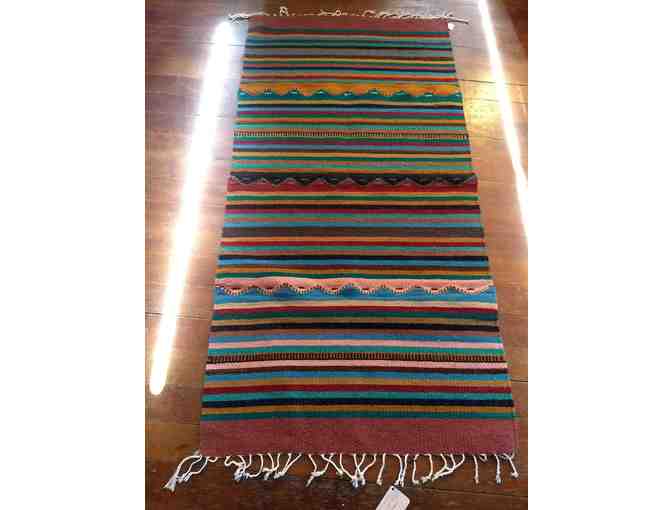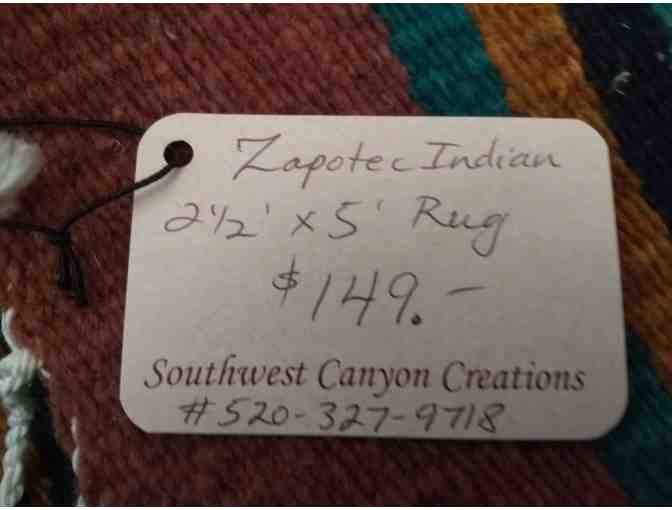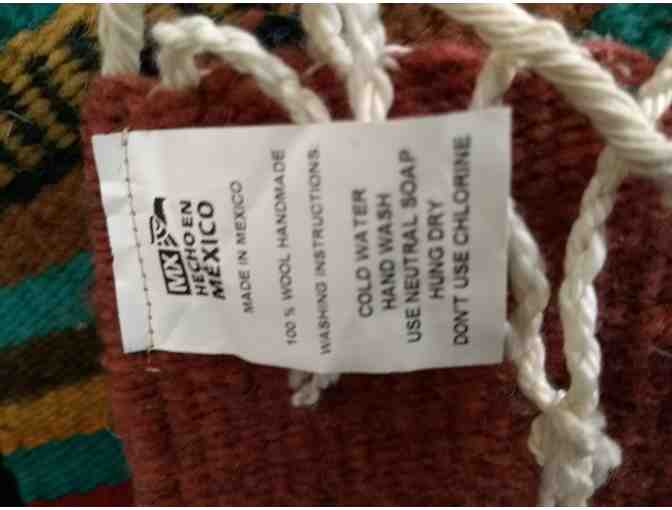Home
Zapotec Wool Rug - 2-1/2 X 5'
- Item Number
- 272
- Estimated Value
- 150 USD
- Sold
- 80 USD to nh54631b5
- Number of Bids
- 9 - Bid History
Item Description
Zapotec Wool Run - size 30" X 60" from
Southwest Canyon Creations
5458 E Pima St, Tucson, AZ 85712
520-327-9718
Welcome to Southwest Canyon Creations. A unique Southwestern furnishings company based in Tucson, Arizona for 24 years. We specialize in bringing the elegance and beauty of the southwest into your home or business.
We carry unique Southwestern, Mexican and Rustic furniture & accessories that are of the highest quality offered at surprisingly low prices.
We are Open:
Tuesday-Friday: 10:00a.m. - 5:30p.m.
Saturday: 11:00a.m. - 4:00p.m.
Closed Sundays & Mondays
Zapotec Rugs History
Teotitlan del Valle is located 30 km from Oaxaca City in the east of the Central Valley Region, at the foothills of the Juarez Mountain Range. It is believed Teotitlan was one of the first Zapotec cities founded at least 2500 years ago; they named it Xaquixe which means at the foot of the mountain.
The Zapotecs, who established in Oaxaca's Central Valley, were one of the most important civilizations of Mesoamerica. Monte Alban was their most important and one of the largest cities of the time; its remains account for the Zapotecs buildings, funerary crypts and ball courts.
The Zapotecs were farmers, weavers, metal smiths and potters. They were together with the Mayan the only cultures in the area to create a complete writing system.
By the end of Mesoamerican Classic Period (1000 A.C.) Monte Alban lost control of the other Zapotec cities in the Valley and eventually was abandoned. The most important City for the Zapotecs became Mitla.
The Central Valley was then politically and culturally influenced by the Mixtecs who eventually took control of Monte Alban and Mitla. The remains in Mitla show how the buildings were originally built by the Zapotecs and later rebuilt and decorated by the Mixtecs.
By the second half of the 15the century the Central Valley was dominated by the Aztecs and many towns were renamed in Nahuatl. Xaquixe's name was changed to Teotitlan which means place of the gods in Nahuatl. Teotitlan paid a back strap loom woven cotton cloths tribute to the Aztecs.
In 1521 Teotitlan, like most cities in the Central Valley, surrendered pacifically to the Spaniards. Del Valle (from the Valley) was added to its name and a catholic temple was built on top of the town's original ceremonial place. The Church named the Precious Blood of Christ was built with some of the pre-Hispanic engraved monoliths.
Around 1535 Dominican Friar Juan Lopez de Zarate brought the first sheep to Teotitlan introducing the native people to the use of the foot loom and all the techniques associated with wool weaving.
The vegetal and animal dyes used in the area were enriched with the mineral ones brought by the Spaniards. Teotitlan weavers began making wool tapestries, sarapes and clothes with their traditional patterns.
By the 1920's, as dress costumes changed, Teotitlan's weavers ceased making the wool garments that were sold locally and in Puebla and Mexico City and specialized in wall hangings and rugs.
In the 1950's, with the arrival of foreign tourism, Teotitlan's weavings became internationally famous, sales arose and the whole family became involved in the weaving process. Traditionally a farming community nowadays most families have left their fields to become fulltime weavers.
Item Special Note
Winner must pick up at our main studios during regular business hours, 220 S 4th Avenue, Tucson AZ 85701.
Donated By:
KXCI 91.3FM Community Radio stores data...
Your support matters, so KXCI 91.3FM Community Radio would like to use your information to keep in touch about things that may matter to you. If you choose to hear from KXCI 91.3FM Community Radio, we may contact you in the future about our ongoing efforts.
Your privacy is important to us, so KXCI 91.3FM Community Radio will keep your personal data secure and KXCI 91.3FM Community Radio will not use it for marketing communications which you have not agreed to receive. At any time, you may withdraw consent by emailing Privacy@frontstream.com or by contacting our Privacy Officer. Please see our Privacy Policy found here PrivacyPolicy.




